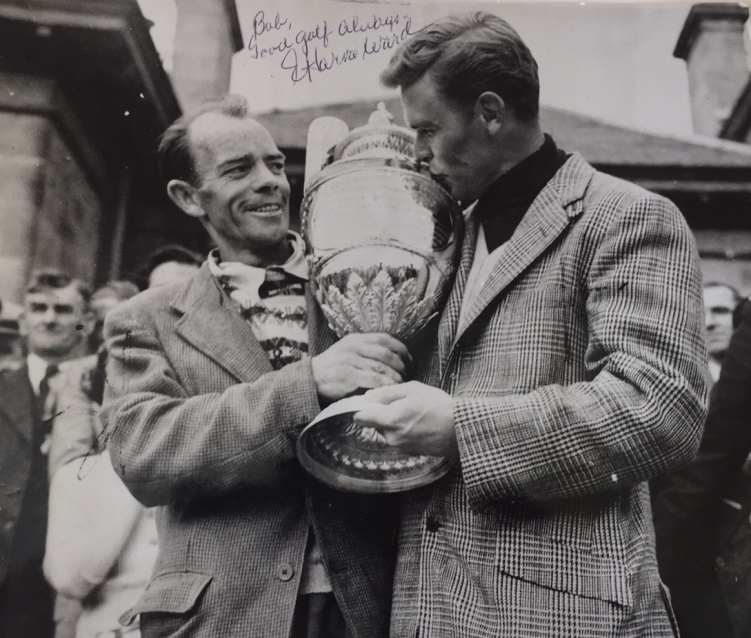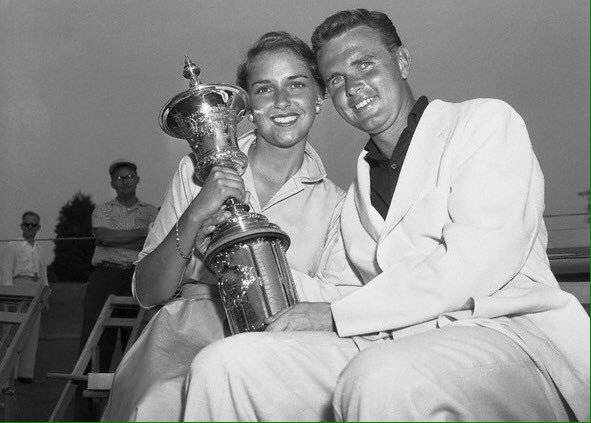18th October 2019
The story of Harvie Ward is something of a rollercoaster – great golfing achievements followed by public humiliation and self destruction before thankfully redemption and a happy ending.
Ward’s place in golfing history is founded upon him being a past winner of both the Amateur (1952) and U.S. Amateur (1955 & ’56) Championships. He is just one of 13 golfers to have achieved this feat.
Edward Harvie Ward Jr. was born on 8th December 1925 in Tarboro, North Carolina. He was a charismatic man with Hollywood good looks who lived life to the full.

Harvie Ward at the 1948 North & South Championship (Photo: The Tufts Archive)
Ward was a successful junior and quickly became one of the U.S.’s leading amateur golfers. He was a natural who seemed to find the game relatively easy. He had a smooth three quarter length swing and an impeccable short game. He played aggressively but normally in a relaxed fashion, although when the mood took him he could also reveal a steely determination to win. This made him a popular figure amongst both his peers and the public. He also enjoyed the patronage of Bobby Jones, who saw him as his heir apparent, which only added to his appeal.
Herb Warren Wind, the American golf writer, called Ward “the most talented amateur of the decade”. In addition to his majors Ward also won the 1948 North and South Amateur, the 1949 NCAA Division I Individual Championship, representing the University of North Carolina where he earned a degree in Economics, and the 1954 Canadian Amateur.
His breakthrough win came in his first Amateur Championship in 1952 where he beat his American rival Frank Stranahan 6&5. He was runner-up in 1953 with Joe Carr getting the better of him in that year’s final.

Harvie Ward with the Amateur trophy in 1952 (Photo: Old Sports Auctions)
He played on the USA’s Walker Cup teams of 1953, 1955 and 1959 and won all six of his 36 hole games. The highlights were a 9&8 foursomes win alongside Jack Westland against John Langley and Arthur Perowne in 1953, a 6&5 singles win against Ronnie White in 1955 and another 9&8 singles win in 1959 against Guy Wolstenholme.
Ward had entered eight U.S. Amateurs before finally winning the Championship in 1955. He beat Bill Hyndman by 9&8 at the Country Club of Virginia in Richmond. He then successfully defended the title in 1956 at Knollwood Club, near Chicago overcoming Charles Kocsis 5&4.
He was prevented from going for a hat trick of U.S. Amateur’s (and from playing in that year’s Walker Cup match) when his amateur status was revoked for 12 months by the USGA on 7th June 1957. Ward’s employer Eddie Lowery, coincidentally caddie for Francis Ouimet when he won the 1913 U.S. Open, became embroiled in a tax investigation which exposed the fact that he had paid the golfer expenses to support his participation in various amateur events. As Ward was the reigning U.S. Amateur champion and Lowery a current member of the USGA Executive Committee it was not a matter that could simply be ignored as many other amateur status cases seemed to be at that time.
The reinstated Ward won his first round match in the 1958 U.S. Amateur taking his total to 17 consecutive victories in the Championship. This broke W. Lawson Little’s previous record of 16 wins in 1934 and 1935 when he also won the Championship two years running. Tiger Woods hat trick of wins in 1994-95-96 set a new mark of 18 which is unlikely to ever be beaten.
Peaking in a very different era to the one we see today Ward opted for a flexible career in business that allowed him to continue playing amateur golf whenever he wished to. He was initially a stockbroker in Atlanta before moving to San Francisco where he was a car salesman.
In total Ward played in 11 Masters as an amateur from 1948-66, finishing in the top 24 four times. His best finish of 4th came in 1957. He was only one behind Sam Snead with 18 holes to play before Doug Ford shot a final round 66 to come through for a 3-shot win. Jones and Roberts were appalled at the treatment of Ward by the USGA and encouraged him to play in the 1958 Masters despite his ongoing ban from USGA events. Sadly his game wasn’t up to the challenge and he missed the cut. He wouldn’t play at Augusta again until his final Masters in 1966.
Ward competed in eight U.S. Opens; his best finish being sixth in 1955.

Suzanne and Harvie Ward with the U.S. Amateur trophy (Photo: Getty Images)
Harvie Ward was one of the four participants in ‘The Greatest Match Ever Played’, contested on 11th January 1956 at Cypress Point G.C. The match was arranged between Lowery and fellow millionaire George Coleman at a pre Crosby Pro-Am Tournament cocktail party. “My two amateurs (Ken Venturi and Ward were both ‘employed’ at his Van Etta Motors car dealership business) can beat any two pros in the world. I’ll put ten thousand dollars on it.” bragged Lowery. Coleman’s response was “I’ll get Nelson and Hogan and we’ll play tomorrow.” The full story of ‘The Match’, was told in a book by Mark Frost (2007). The Pros won by 1-hole with Hogan reportedly shooting 63 (-9), Venturi 65, Ward 67 and the by then 10 year retired Nelson 67.
The 1957 ban over his amateur status had a profound impact on Ward’s life. His friendship with Lowery, who he had trusted with his finances, collapsed and he left his role at Van Etta shortly afterwards. He started to drink heavily and became something of a womaniser both of which led to the collapse of his three year old marriage to Suzanne, the couple having also adopted two children.
He successfully sought his reinstatement as an amateur via the USGA in May 1958 but much of his golfing spark had gone and he never really rediscovered his best from. With Arnold Palmer making waves in the professional game and a dominating Jack Nicklaus now emerging on the amateur side America’s golfing eyes had started to look elsewhere for their next hero. It took Ward nearly 20 years, including two more marriages, to get over how his life had changed from the heady days of the early 1950’s and he played little golf during this period of his life.
Ward eventually turned professional in 1974 to try and earn a living and to simply get back on track. He was 48 by then and obviously was unable to compete with the youngsters on the mini-tours let alone the PGA Tour. Instead he returned to his native North Carolina to become head golf professional at Foxfire Country Club. As he helped ordinary golfers improve he gradually started to find his feet again. He went on to work at Grand Cypress Golf Club in Orlando at the invitation of the designer Jack Nicklaus.
Ward even started to play a few events on the PGA Senior Tour at this time. The highlight of this renaissance was his win at the 1980 Senior Open, the year before it became an official USGA Championship.
He subsequently worked at Interlachen Golf Club in Winter Park, Florida before moving back home to the Pinehurst area in 1989 where he further cemented his reputation as a teaching professional. He was named “Teacher of the Year” by the PGA in 1990 during a 15 year career at Pine Needles Lodge & Country Club in Southern Pines. Notably Payne Stewart turned to Ward after his own dad, and only coach up until that point, had died.
Harvie Ward died at his home in Pinehurst, North Carolina on 4th September 2004, aged 78, having previously been diagnosed with advanced lung cancer. He was survived by his fourth wife Joanne who he had met 20 years earlier during his time in Orlando.
Ward is rightly considered one of the best amateur golfers of all time but one can not help but think that is potential was ultimately not fulfilled.
ME.
Copyright © 2014-2023, Mark Eley. All rights reserved.